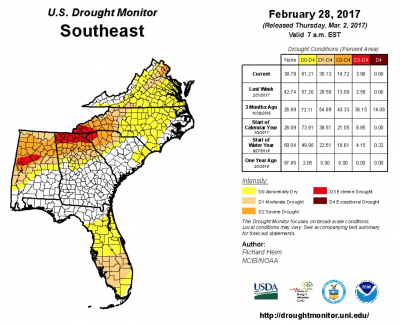Beef prices are projected to continue increasing as U.S. beef production declines with no signs of a cattle herd rebuild. Additionally, cheap beef may soon become further out of reach…
Federal Reserve: Observations on the Ag Economy- February ’17
Last week, the Federal Reserve Board released its February ’17 Beige Book update, a summary of commentary on current economic conditions by Federal Reserve District. The report included several observations pertaining to the U.S. agricultural economy.

* Fifth District- Richmond– “Agriculture conditions were largely unchanged at typical seasonal levels. Demand for poultry rose moderately. Some expansions were reported at poultry farms in North Carolina.”
* Sixth District- Atlanta– “Agriculture conditions across the District were mixed. By early February, rain brought some improvement to drought conditions. However, much of the District continued to experience varying degrees of drought with small areas of north central Alabama and northeastern Georgia categorized in extreme drought. Florida’s February orange forecast was down from January, remaining below last season’s production. On a year-over-year basis, prices paid to farmers in December were up for cotton, soybeans, and broilers, but down for corn, rice, beef, and eggs.”

* Seventh District- Chicago– “Prospects for farm income in 2017 improved slightly in January and early February, although the agricultural sector continued to operate under stress. Futures prices moved up enough so that – given expected costs – some corn and most soybean operations could lock in small profits for 2017.
With profit margins looking to be higher for soybeans than for corn, contacts expected a shift in the mix of planting this year, with one reporting an attendant pickup in sales of soybean seeds.
Look at soybean/corn price ratios in February - Rachel Trego @USDAForeignAg presentation at @usda outlook forum last week pic.twitter.com/1jPFK3SOiO
— Farm Policy (@FarmPolicy) February 28, 2017
“Cattle, dairy, and hog operations all benefitted from price increases.”
* Eighth District- St. Louis– “Agriculture conditions were unchanged from the previous report. As of the end of January, more than 94 percent of District winter wheat was rated fair or better, a slight improvement over crop condition at the end of January 2016 and the current crop’s condition at the end of December. However, contacts reported that lower grain prices continued to affect farmers in the area, who have further reduced investment in land and equipment.
~ 22% of winter wheat production is w/i an area experiencing drought (Weekly Agriculture in Drought Report, @USDA Office of Chief Economist pic.twitter.com/Gu3FQLxdC8
— Farm Policy (@FarmPolicy) March 2, 2017
* Ninth District- Minneapolis– “District agricultural conditions remained weak since the previous report. Respondents to the Minneapolis Fed’s most recent (January) survey of agricultural credit conditions indicated that farm incomes and capital spending fell in the fourth quarter of 2016 relative to a year earlier, with similar expectations for the coming three months.”
* Tenth District- Kansas City– “Farm income remained subdued in the Tenth District, and farmland values declined modestly since the last reporting period. Cattle, wheat, and corn prices were lower than a year ago in early February and continued to weigh on farm income in the District, despite slight improvements in hog and soybean prices.
All District states reported slightly lower farm income and expected further declines in the coming months. Farmland values and cash rental rates for farmland continued to trend lower at a modest pace and were also expected to decline further in the months ahead.
“Alongside persistent declines in farm income and farmland values, agricultural credit conditions weakened modestly, as farm loan repayment rates edged lower and demand for short-term financing remained strong.”
* Eleventh District- Dallas– “Moisture levels remained favorable across the district. The wheat crop was in great shape, and row crop producers began field preparation in many areas and even started planting in some of the southern parts of Texas. Cattle prices continued to rally, due in part to seasonality but also a combination of ample demand and a tighter supply of cattle ready for market. Contacts noted an increase in beef exports. Cotton exports have been trending up so far this quarter, thanks in part to the strong quality of the 2016 cotton crop. Cotton prices were relatively strong, and contacts expect a large increase in cotton acreage this year. Other crop prices trended up over the reporting period. Wheat prices still generally remained below breakeven prices, but corn and sorghum prices rose to a profitable level for many producers.”
When I started #plant17 on Feb 9th, I should have kept rolling hard. Early corn looks so good. Now on rain delay. pic.twitter.com/SPN2p0hznN
— Allen Meissner (@bigaljack) March 6, 2017
* Twelfth District- San Francisco– “Activity in the agriculture sector was little changed from the previous reporting period. Demand for timber remained strong, and contacts reported that domestic wood products manufacturers expanded production as input costs were low and margins remained favorable. A major buyer of barley notified producers in Idaho that their purchases would decrease by 30 percent in 2017. Weak global prices and increased production costs in California further reduced rice plantings. Overall, the elevated dollar continued to suppress agriculture exports. Wet winter conditions increased snowpack in the Sierra Nevada, and contacts expected increased water supplies to boost harvests later this year.”





